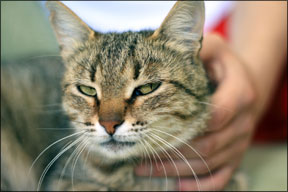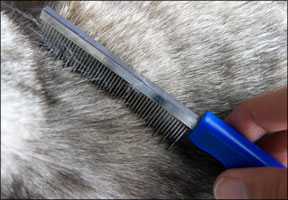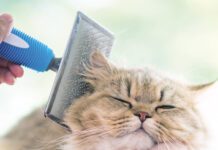The owner is the veterinarians eyes and hands away from the office,” explains Fred Scott, DVM, PhD, interim director of Cornells Feline Health Center. For this reason, it is important to be familiar with the steps involved in doing an at-home mini-physical examination on your cat. This should supplement your cats twice Bev Caldwell 288 yearly trips to the veterinarian. Easier Than You Think. Performing an at-home physical examination is much easier than you might think; in fact, Dr. Scott points out, the examination should be a normal extension of the regular attention you give your cat. Here are some easy-to-follow ground rules: -Dont restrain your cat when you do the examination. She should be comfortably nestled in your lap or, if shes not a lap cat, you can place her on a raised surface. -No fighting. If she starts to struggle, take a break. -Never attempt an examination after a play session. The best thing is to do it when your cat is quiet and relaxed. -Its not necessary to complete the whole examination at once. You can do a little at a time over the course of a week. Getting Started. If you have a weekly grooming ritual, thats a great time to look at the condition of your feline friends skin and coat. First, look for any hair loss (which could indicate fleas or another skin disorder), patchy spots, lumps and bumps. Be sure to observe your cats belly, as mammary cancer is a concern with cats, especially unspayed females. Check for swellings and asymmetrical and/or painful areas. Next, look at your cats rear end. Lift her tail and check for tapeworm infection, which will appear as rice-like segments stuck in the hair. Also, if your cat has long hair, make sure she doesnt have feces matted in the hair on her bottom. Inspect her toes to make sure she doesnt have any ingrown toenails. This is a special concern with older cats, and may be an issue with polydactyl cats (cats with extra toes). Ears and Eyes. Your cats ears should be light pink (unless theyre pigmented) and there should not be any odor or discharge. To look down into the depths of your cats ear, you can gently pull the top of the ear upward. Next, you should check your cats eyes to ensure that the pupils Bev Caldwell 288 are the same size, that there is no tearing or discharge, and that the third eyelid (nictitating membrane) isnt drawn over the eye. Also, your cat shouldnt be squinting. If she tolerates it, you can pull out the lower eyelid, which should be pink, not red or white. Open Wide. Finally, its time to look in her mouth. Gums (like other tissue) should be a healthy pink, and teeth should not be too tartar encrusted. Familiarize yourself with your cats normal breath: Although its never exactly lovely to sniff, it shouldnt be disgusting. Make sure she isnt drooling or suffering from loose, missing or broken teeth. In a short amount of time, as Dr. Scott explains, you will have made sure that “everything is going as it should.” Its important to watch for slight changes in behavior, as well as any physiological problems. Subtle signs of illness include lethargy, change in appetite and water consumption (eating or drinking more or less than usual), changes in grooming behavior (oily coat or overgrooming are red flags), weight loss and any changes in litter box behavior. If you have any concerns, a visit to the veterinarian is in order. 




